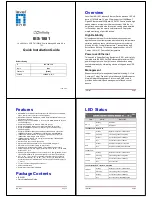
st
eut
e T
echnol
ogies GmbH & Co. K
G
Brück
ens
tr
aße 91, 32584 Löhne, Germany
, www
.s
teut
e.c
om
//
RF 96 ST SW868/SW915/SW917/SW922 Vcc extern
2 / 16
Montage- und Anschlussanleitung / Funkschalter
Mounting and wiring instructions / Wireless switch
Instructions de montage et de câblage / Interrupteur sans fil
Istruzioni di montaggio e collegamento / Interruttore wireless
Instruções de montagem e instalação / Interruptor de rádio frequência
Инструкция по монтажу и подключению / Радио-выключатель
English
Destination and use
The device of type SW868 is intended for use in the European Union. It
complies with the European Union’s Directive 2014/53/EU (RED) for
radio equipment.
The device of type SW915 is intended for use in Canada, USA, and Mex-
ico. It complies with the requirements of FCC Rules and IC Rules, RSS-
210. It has an approval number for the Mexican states.
The device of type SW917 is intended for use in Brazil. It complies with
the requirements of Resolucão 242/2000.
The device of type SW922 is intended for use in Japan. It complies with
the requirements of ARIB STD-T108.
The device essentially comprises three parts: the voltage supply, the
wireless part with integrated interface for the external sensors and the
connection part for the external sensors. Voltage supply is connected
via a M12 plug-in connector. The sensors or switches can be connected
in the wiring compartment under the cover. This terminal allows con-
necting with various sensors with PNP output or other mechanical
switches with gold-plated contacts. The connecting cable, Material no.
1189960, can be used. It is available as an accessory. The mechanical
switches must be equipped with a NO/NC contact. It must be connect-
ed to plus (pin 1) and to the entry (pin 4). When exceeding the thresh-
old, the wireless part sends a signal. The transmission is carried out at
a frequency of 868.3 MHz (EU) or 915.0 MHz (USA, Canada, Mexico) or
917.0 MHz (Brazil) or 916.5 MHz (Japan). The receiver must conform to
the sWave® protocol of the steute module. The wireless sensor's volt-
age is supplied via a M12 plug-in connector. It is equipped with an in-
ternal voltage control to supply the wireless module. The external sen-
sor must have a PNP output and controls the wireless module via an
interface. Alternatively, a mechanical contact can be connected which
switches A to +.
Mounting / Wiring
Mount the wireless switch on an even surface. The wireless switch
must be installed according to the mounting and wiring instruc-
tions of the receiver. The wireless range accordingly depends on the
local conditions. Thus, the radio signal can be strongly affected by
conductive materials. This also includes thin foils, e.g. aluminium
laminations on insulation materials. A test with the field strength
indicator swView 868, Material no. 1190393, or swView 915, Material
no. 1221794, should be carried out (swView 922 and swView 917 on
request only).
Design of wireless range
Because radio signals are electromagnetic waves, the signal is attenu-
ated on its way from the transmitter to the receiver. This means the
electrical as well as the magnetic field strengths decrease inversely
proportionally to the squared distance of transmitter and receiver
(E,H~1/r²). In addition to this natural restriction of the wireless range,
further interference factors occur: metal parts, e.g. armours in walls,
metal foils of thermal insulations or vapour deposited metal layer heat
protection glass, reflect electromagnetic waves. Therefore, a so-called
deadspot can be found behind them. Radio waves are able to penetrate
walls but the attenuation increases even more than in the free field.
Penetration of radio waves:
wood, gypsum, glas uncoated
90...100%
brick stone, press boards
65...95%
armoured concrete
10...90%
metal, aluminium lamination, water
0...10%
Typical wireless ranges are:
Sight connection in free field:
approx. 450 m
Sight connection indoors:
approx. 40 m
Sight connection in free field (SW922):
approx. 150 m
Sight connection indoors (SW922):
approx. 20 m
Notices
The processing of one switching command from transmitter to receiv-
er lasts approx. 80 to 100 ms on basis of the sWave® data transmis-
sion. The switching signal of a transmitter must not be generated in
shorter time sequences otherwise this signal will be suppressed. Sub-
ject to technical modifications. Reconstruction and alterations at the
device are not allowed. Moreover, steute does not assume any liability
for recommendations made or implied by this description. From this
description new claims for guarantee, warranty or liability cannot be
derived beyond the general terms and conditions of delivery.
Maintenance
With rough conditions, we recommend routine maintenance as follows:
1. Remove all dirt or particles.
Cleaning
- In case of damp cleaning: use water or mild, non-scratching, non-
chafing cleaners.
- Do not use aggressive cleaners or solvents.
Clean enclosure on the outside only. Clean enclosure with household
cleaning agents. Do not use compressed air to clean.
Disposal
- Observe national, local and legal regulations concerning disposal.
- Recycle each material separately.


































